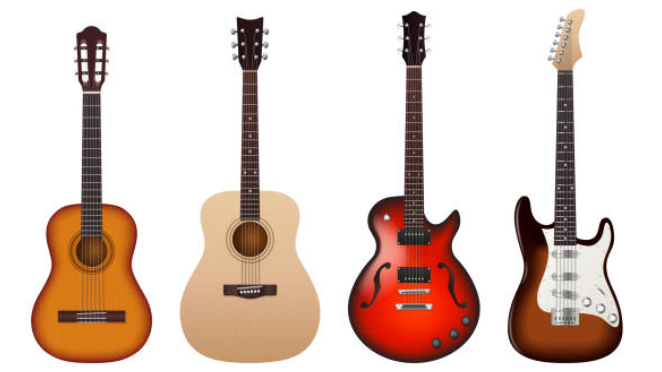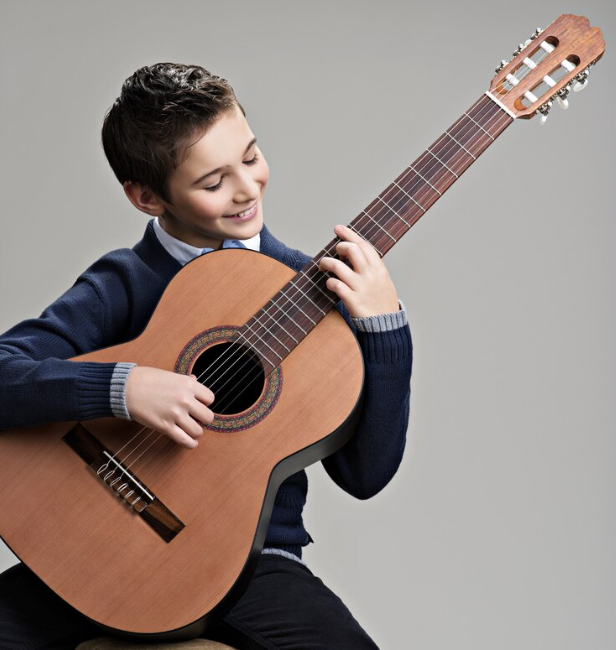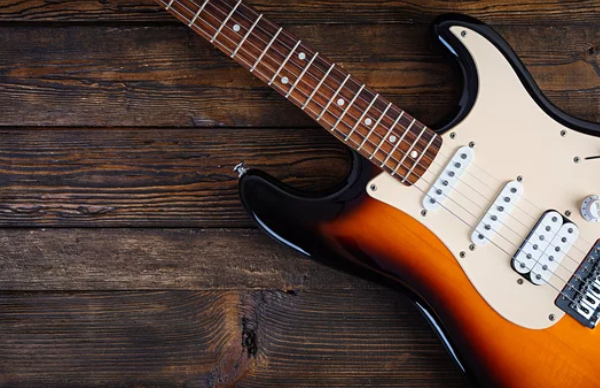Know It All About The A Minor Pentatonic Scale

The A minor pentatonic scale is a simple yet powerful tool in the arsenal of musicians, from guitarists to pianists, and is beloved for its melodic versatility and emotional depth. This blog post will explore the scale’s structure, its application, and some tips on how to incorporate it into your playing to enhance your musical expression.
What is the A Minor Pentatonic Scale?
The pentatonic scale is a musical scale with five notes per octave, in contrast to the more common heptatonic scale, which has seven notes. The term “pentatonic” comes from the Greek words “pente” (five) and “tonic” (tone). The A minor pentatonic scale specifically consists of the following notes: A, C, D, E, and G.
Scale Structure
To understand the structure of the A minor pentatonic scale, let’s start from its root note, A. Here’s how the notes are arranged:
- A (Root)
- C (Minor third)
- D (Perfect fourth)
- E (Perfect fifth)
- G (Minor seventh)
This arrangement skips the second and sixth degrees typical to natural minor scales, which in the case of A minor would be B and F. This omission gives the pentatonic scale its unique character and accessibility.
Applications in Music
The A minor pentatonic scale is extremely versatile. It is often used in:
- Blues Music: It’s perhaps most famously used in blues where it’s played over both major and minor progressions, giving the blues its distinctive wailing sound.
- Rock Music: From classic rock solos to modern metal riffs, the A minor pentatonic can be heard all over rock music.
- Jazz Music: Jazz musicians use the pentatonic scale to add a modern sound to their solos, often blending it with other scales and modes.
- Pop Music: Many catchy hooks in pop music are derived from pentatonic scales, as their simplicity makes them memorable.
Fingering the A Minor Pentatonic Scale
Position 5
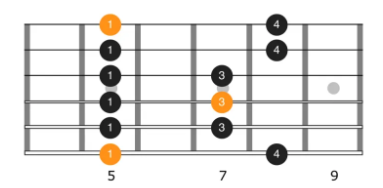
When you begin playing the A minor pentatonic scale in its first position on the guitar, you’ll start with the A note located at the 5th fret on the 6th string.
In this position, you can identify three A notes that create a triangular shape across the fretboard. Here’s where you’ll find them:
- 5th fret on the 6th string
- 7th fret on the 4th string
- 5th fret on the 1st string
It’s interesting to note that this pattern can be replicated higher up on the fretboard. You can find the same sequence starting at the 15th fret of the 6th string. Despite changing octaves, the spatial relationship between the intervals remains consistent. For instance, from any root note on the 6th string, moving two strings up and two frets forward will always lead you to another root note. This consistent pattern can help guide your navigation across the fretboard as you play.
Position 7
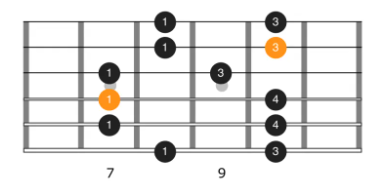
The seventh position of the A minor pentatonic scale smoothly transitions from the first and covers the following notes along the fretboard:
- C (flat third) on the 6th string
- E (perfect fifth) on the 5th string
- A (root note) on the 4th string
- D (perfect fourth) on the 3rd string
- G (flat seventh) on the 2nd string
- C (flat third) on the 1st string
In this position, you’ll find two A notes that establish an octave: one is located at the 7th fret on the 4th string, and the other at the 10th fret on the 2nd string. These create a recognizable octave pattern that’s easy to follow.
The typical fingering for this scale position utilizes the index, ring, and pinky fingers, providing a straightforward method to navigate these intervals. However, you might consider using your middle finger for the notes on the 8th frets of the 6th, 2nd, and 1st strings. This slight adjustment can help maintain a comfortable hand position across the fretboard without needing to shift your hand too much, keeping the standard 1-3 finger pattern consistent.
Position 9
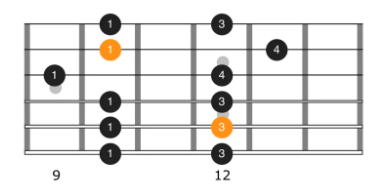
The ninth position of the A minor pentatonic scale extends from the second and includes the following notes:
- D (perfect fourth) on the 6th string
- G (flat seventh) on the 5th string
- C (flat third) on the 4th string
- E (perfect fifth) on the 3rd string
- A (root note) on the 2nd string
- D (perfect fourth) on the 1st string
This position features two root notes, located on the 2nd and 5th strings. These root notes are excellent anchor points to begin exploring the nuances of the scale across the fretboard.
Playing through this position typically involves shifting your hand position at least once. The standard fingering might require two shifts, but you can reduce this to a single shift by using your middle finger instead of your index finger on the 4th, 5th, and 6th strings. This adjustment helps keep your hand movements smooth and efficient. While the fingering suggested here is common, feel free to adapt it based on what feels most comfortable or practical, especially in the context of the music you are playing.
Position 12

Position twelve of the A minor pentatonic scale flows seamlessly from position three and includes these notes:
- E (perfect fifth) on the 6th string
- A (root) on the 5th string
- D (perfect fourth) on the 4th string
- G (flat seventh) on the 3rd string
- C (flat third) on the 2nd string
- E (perfect fifth) on the 1st string
In this position, you’ll find the root notes on the 5th and 3rd strings, which together create a familiar octave shape that’s easy to recognize and utilize.
The fingering for this fourth position is generally straightforward. However, some players might find it comfortable to use the middle and pinky fingers for playing the notes on the 2nd string, helping to keep the hand relaxed and agile across the fretboard. This setup allows for smooth transitions and easier reach between notes.
Position 14

The final position of the A minor pentatonic scale connects back to the fourth position with the following notes:
- G (flat seventh) on the 6th string
- C (flat third) on the 5th string
- E (perfect fifth) on the 4th string
- A (root) on the 3rd string
- D (perfect fourth) on the 2nd string
- G (flat seventh) on the 1st string
This position also seamlessly links back to the first as the cycle of scale positions begins anew. The connection points are:
- A (root) on the 6th string
- D (perfect fourth) on the 5th string
- G (flat seventh) on the 4th string
- C (flat third) on the 3rd string
- E (perfect fifth) on the 2nd string
- A (root) on the 1st string
Just like in the first position, the fifth position features three root notes located on the 6th, 3rd, and 1st strings, providing strong tonal anchors throughout the scale.
The standard fingering suggested in diagrams might include adjustments such as using the middle and pinky fingers for playing the notes on the 6th, 5th, 2nd, and 1st strings. This alternative can help facilitate smoother transitions and maintain comfort during play, especially over extended sessions or complex passages.
Tips for Practice
- Start Slow: Learn the scale thoroughly at a slow tempo before speeding up.
- Use a Metronome: This helps in keeping your timing accurate and your playing steady.
- Experiment with Phrasing: Try playing the scale notes in different orders, rhythms, and dynamics.
- Play Along with Tracks: This can help you understand how the scale fits within different harmonic contexts.
To wrap up, the A minor pentatonic scale is a gateway to musical expression, offering a straightforward yet effective approach to soloing, improvisation, and melody writing. Whether you’re a beginner looking to understand musical scales or an advanced player exploring new sounds, the A minor pentatonic scale provides a foundation for creative and dynamic music-making.
Whether you’re practicing alone or jamming with friends, this scale is sure to add some soulful sounds to your music. Happy playing!
If you’re interested in learning an instrument, at Real Brave, we offer an incredible experience like no other place in music lessons for kids and adults by guiding them from the beginning stages of getting to know an instrument all the way through performing for family and friends on stage. Our instructors come from all over the world, bringing extensive experience on a wide range of instruments. Click below and book a free lesson with us!
Author: Daniel Powers Jr, the founder of Real Brave™, serves as the chief inspiration to thousands of students in the Real Brave music instruction program. He’s also the visionary behind PracticePad™, an online platform for live one-on-one online music lessons, lesson tracking, and scheduling. Beyond his entrepreneurial pursuits, Daniel leads a non-profit organization that provides formerly homeless children with access to music education, making a profound impact on their lives. His unwavering dedication to music, innovation, and education continues to inspire individuals to reach their fullest potential while creating positive change in communities. Follow Real Brave on all the socials:
youtube.com/@realbraveinc
twitter.com/realbraveinc
https://www.tiktok.com/@realbraveinc
instagram.com/realbraveaudio
facebook.com/realbraveinc




